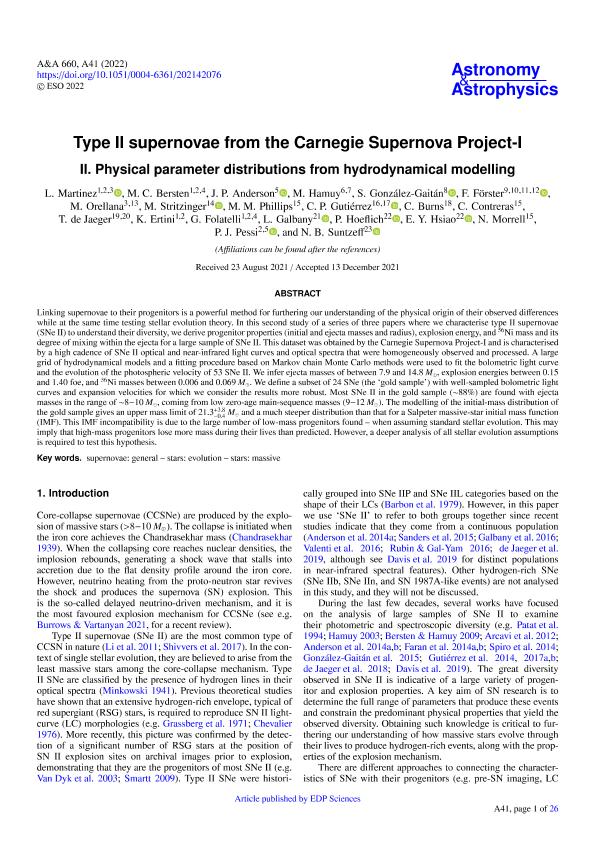Artículo
Type II supernovae from the Carnegie Supernova Project-I: II. Physical parameter distributions from hydrodynamical modelling
Martinez, Laureano ; Bersten, Melina Cecilia
; Bersten, Melina Cecilia ; Anderson, J. P.; Hamuy, Mario; González Gaitán, S.; Förster, F.; Orellana, Mariana Dominga
; Anderson, J. P.; Hamuy, Mario; González Gaitán, S.; Förster, F.; Orellana, Mariana Dominga ; Stritzinger, Maximilian; Phillips, M. M.; Gutiérrez, C. P.; Burns, C.; Contreras, C.; de Jaeger, T.; Ertini, Keila Yael
; Stritzinger, Maximilian; Phillips, M. M.; Gutiérrez, C. P.; Burns, C.; Contreras, C.; de Jaeger, T.; Ertini, Keila Yael ; Folatelli, Gaston
; Folatelli, Gaston ; Galbany, Lluís; Hoeflich, Peter; Hsiao, Eric; Morrell, Nidia Irene
; Galbany, Lluís; Hoeflich, Peter; Hsiao, Eric; Morrell, Nidia Irene ; Pessi, Priscila Jael
; Pessi, Priscila Jael ; Suntzeff, Nicholas B.
; Suntzeff, Nicholas B.
 ; Bersten, Melina Cecilia
; Bersten, Melina Cecilia ; Anderson, J. P.; Hamuy, Mario; González Gaitán, S.; Förster, F.; Orellana, Mariana Dominga
; Anderson, J. P.; Hamuy, Mario; González Gaitán, S.; Förster, F.; Orellana, Mariana Dominga ; Stritzinger, Maximilian; Phillips, M. M.; Gutiérrez, C. P.; Burns, C.; Contreras, C.; de Jaeger, T.; Ertini, Keila Yael
; Stritzinger, Maximilian; Phillips, M. M.; Gutiérrez, C. P.; Burns, C.; Contreras, C.; de Jaeger, T.; Ertini, Keila Yael ; Folatelli, Gaston
; Folatelli, Gaston ; Galbany, Lluís; Hoeflich, Peter; Hsiao, Eric; Morrell, Nidia Irene
; Galbany, Lluís; Hoeflich, Peter; Hsiao, Eric; Morrell, Nidia Irene ; Pessi, Priscila Jael
; Pessi, Priscila Jael ; Suntzeff, Nicholas B.
; Suntzeff, Nicholas B.
Fecha de publicación:
04/2022
Editorial:
EDP Sciences
Revista:
Astronomy and Astrophysics
ISSN:
0004-6361
Idioma:
Inglés
Tipo de recurso:
Artículo publicado
Clasificación temática:
Resumen
Linking supernovae to their progenitors is a powerful method for furthering our understanding of the physical origin of their observed differences while at the same time testing stellar evolution theory. In this second study of a series of three papers where we characterise type II supernovae (SNe II) to understand their diversity, we derive progenitor properties (initial and ejecta masses and radius), explosion energy, and 56Ni mass and its degree of mixing within the ejecta for a large sample of SNe II. This dataset was obtained by the Carnegie Supernova Project-I and is characterised by a high cadence of SNe II optical and near-infrared light curves and optical spectra that were homogeneously observed and processed. A large grid of hydrodynamical models and a fitting procedure based on Markov chain Monte Carlo methods were used to fit the bolometric light curve and the evolution of the photospheric velocity of 53 SNe II. We infer ejecta masses of between 7.9 and 14.8 M, explosion energies between 0.15 and 1.40 foe, and 56Ni masses between 0.006 and 0.069 M. We define a subset of 24 SNe (the gold sample) with well-sampled bolometric light curves and expansion velocities for which we consider the results more robust. Most SNe II in the gold sample (88%) are found with ejecta masses in the range of 810 M, coming from low zero-age main-sequence masses (912 M). The modelling of the initial-mass distribution of the gold sample gives an upper mass limit of 21.3{+3.8} {-0.4}M and a much steeper distribution than that for a Salpeter massive-star initial mass function (IMF). This IMF incompatibility is due to the large number of low-mass progenitors found when assuming standard stellar evolution. This may imply that high-mass progenitors lose more mass during their lives than predicted. However, a deeper analysis of all stellar evolution assumptions is required to test this hypothesis.
Palabras clave:
STARS: EVOLUTION
,
STARS: MASSIVE
,
SUPERNOVAE: GENERAL
Archivos asociados
Licencia
Identificadores
Colecciones
Articulos(IALP)
Articulos de INST.DE ASTROFISICA LA PLATA
Articulos de INST.DE ASTROFISICA LA PLATA
Citación
Martinez, Laureano; Bersten, Melina Cecilia; Anderson, J. P.; Hamuy, Mario; González Gaitán, S.; et al.; Type II supernovae from the Carnegie Supernova Project-I: II. Physical parameter distributions from hydrodynamical modelling; EDP Sciences; Astronomy and Astrophysics; 660; A41; 4-2022; 1-26
Compartir
Altmétricas



